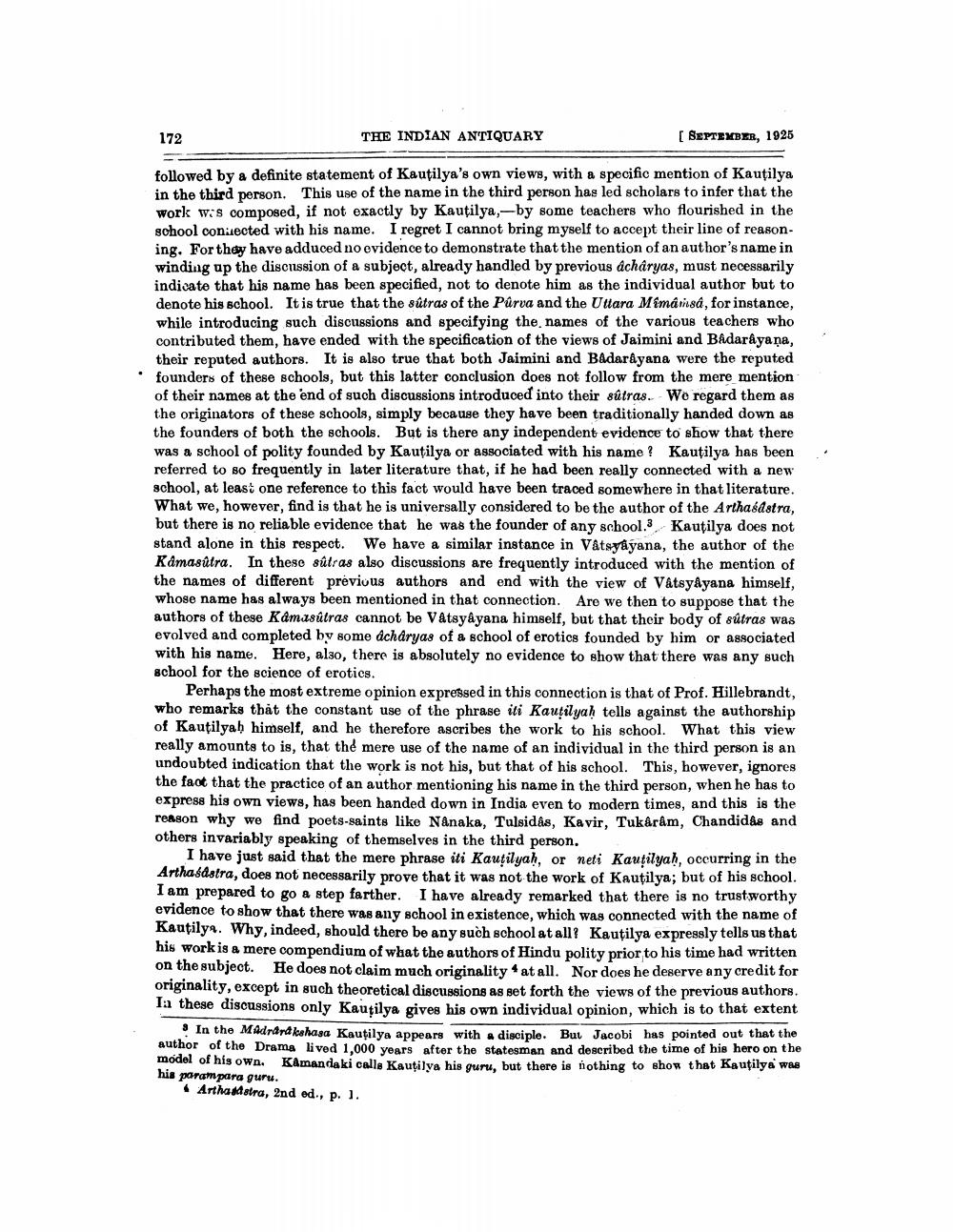________________
172
THE INDIAN ANTIQUARY
[ SEPTEMBER, 1925
followed by a definite statement of Kautilya's own views, with a specific mention of Kautilya in the third person. This use of the name in the third person has led scholars to infer that the work wis composed, if not exactly by Kautilya, -by some teachers who flourished in the school conuected with his name. I regret I cannot bring myself to accept their line of reasoning. For they have adduced no evidence to demonstrate that the mention of an author's name in winding up the discussion of a subject, already handled by previous acharyas, must necessarily indicate that his name has been specified, not to denote him as the individual author but to denote his school. It is true that the sutras of the Půrva and the Uttara Mimamså, for instance, while introducing such discussions and specifying the names of the various teachers who contributed them, have ended with the specification of the views of Jaimini and Badarayaņa, their reputed authors. It is also true that both Jaimini and Badarayana were the reputed founders of these schools, but this latter conclusion does not follow from the mere mention of their names at the end of such discussions introduced into their sútras. We regard them as the originators of these schools, simply because they have been traditionally handed down as the founders of both the schools. But is there any independent evidence to show that there was a school of polity founded by Kautilya or associated with his name? Kautilya has been referred to so frequently in later literature that, if he had been really connected with a new school, at least one reference to this fact would have been traced somewhere in that literature. What we, however, find is that he is universally considered to be the author of the Arthaśdstra, but there is no reliable evidence that he was the founder of any school.3, Kautilya does not stand alone in this respect. We have a similar instance in Våtsyayana, the author of the Kamasutra. In these sutras also discussions are frequently introduced with the mention of the names of different previous authors and end with the view of VatsyAyana himself, whose name has always been mentioned in that connection. Are we then to suppose that the authors of these Kamasutras cannot be Vatsyayana himself, but that their body of sútras was evolved and completed by some acharyas of a school of erotics founded by him or associated with his name. Here, also, there is absolutely no evidence to show that there was any such school for the science of erotics.
Perhaps the most extreme opinion expressed in this connection is that of Prof. Hillebrandt, who remarks that the constant use of the phrase iti Kautilyah tells against the authorship of Kautilyah himself, and he therefore ascribes the work to his school. What this view really amounts to is, that the mere use of the name of an individual in the third person is an undoubted indication that the work is not his, but that of his school. This, however, ignores the fact that the practice of an author mentioning his name in the third person, when he has to express his own views, has been handed down in India even to modern times, and this is the reason why we find poets-saints like Nánaka, Tulsidas, Kavir, Tukaram, Chandidas and others invariably speaking of themselves in the third person.
I have just said that the mere phrase iti Kautilyah, or neti Kautilyaḥ, occurring in the Arthasastra, does not necessarily prove that it was not the work of Kautilya; but of his school. I am prepared to go a step farther. I have already remarked that there is no trustworthy evidence to show that there was any school in existence, which was connected with the name of Kautilya. Why, indeed, should there be any such school at all? Kautilya expressly tells us that his work is a mere compendium of what the authors of Hindu polity prior to his time had written on the subject. He does not claim much originality * at all. Nor does he deserve any credit for originality, except in such theoretical discussions as set forth the views of the previous authors. la these discussions only Kautilya gives his own individual opinion, which is to that extent
In the Midrand kshasa Kautilya appears with a disciple. But Jacobi has pointed out that the author of the Drama lived 1.000 vents after the statesman and described the time of his hero on the model of his own. Kamandaki calle Kautilya his guru, but there is nothing to show that kaupya was his parampara guru.
Artha sastra, 2nd ed., p.).




